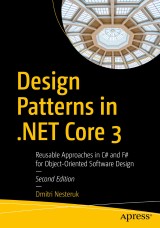Details

Design Patterns in .NET Core 3
Reusable Approaches in C# and F# for Object-Oriented Software Design2nd ed.
|
46,99 € |
|
| Verlag: | Apress |
| Format: | |
| Veröffentl.: | 04.01.2021 |
| ISBN/EAN: | 9781484261804 |
| Sprache: | englisch |
Dieses eBook enthält ein Wasserzeichen.
Beschreibungen
<div>Implement design patterns in .NET Core 3 using the latest versions of the C# and F# languages. This book provides a comprehensive overview of the field of design patterns as they are used in today’s developer toolbox. This new edition introduces topics such as Functional Builder, Asynchronous Factory Method, Generic Value Adapter, and new Composite Proxies, including one that attempts to solve the SoA/AoS problem.</div><div><br></div><div>Using the C# and F# programming languages, <i><b>Design Patterns in .NET Core 3</b></i> explores the classic design pattern implementations and discusses the applicability and relevance of specific language features for implementing patterns. You will learn by example, reviewing scenarios where patterns are applicable. MVP and patterns expert Dmitri Nesteruk demonstrates possible implementations of patterns, discusses alternatives and pattern inter-relationships, and illustrates the way that a dedicated refactoring tool (ReSharper)can be used to implement design patterns with ease.<br></div><div><br></div><div><br></div><div><b>What You Will Learn</b></div><div><ul><li>Become familiar with the latest pattern implementations available in C# 8 and F# 5</li><li>Know how to better reason about software architecture</li><li>Understand the process of refactoring code to patterns</li><li>Refer to researched and proven variations of patterns<br></li><li>Study complete, self-contained examples, including many that cover advanced scenarios<br></li><li>Use the latest implementations of C# and Visual Studio/Rider/ReSharper</li></ul></div><div><br></div><div><b>Who This Book Is For</b></div><div><br></div><div>Developers who have some experience in the C# language and want to expand their comprehension of the art of programming by leveraging design approaches to solving modern problems</div>
<p><b>Part I: Introduction</b>.- Chapter 1: The SOLID Design Principles.- Chapter 2: The Functional Perspective.- <b>Part II: Creational Patterns.</b>- Chapter 3: Builder.- Chapter 4: Factories.- Chapter 5: Prototype.- Chapter 6: Singleton.- <b>Part III: Structural Patterns.</b>- Chapter 7: Adapter.- Chapter 8: Bridge.- Chapter 9: Composite.- Chapter 10: Decorator.- Chapter 11: Façade.- Chapter 12: Flyweight.- Chapter 13: Proxy.- <b>Part IV: Behavioral Patterns.</b> - Chapter 14: Chain of Responsibility.- Chapter 15: Command.- Chapter 16: Interpreter.- Chapter 17: Iterator.- Chapter 18: Mediator.- Chapter 19: Memento.- Chapter 20: Null Object.- Chapter 21: Observer.- Chapter 22: State.- Chapter 23: Strategy.- Chapter 24: Template Method.- Chapter 25: Visitor.</p><p><br></p><p><br></p>
<b>Dmitri Nesteruk</b> is a quantitative analyst, developer, course and book author, and an occasional conference speaker. His interests lie in software development and integration practices in the areas of computation, quantitative finance, and algorithmic trading. His technological interests include C# and C++ programming as well as high-performance computing using technologies such as CUDA and FPGAs. He has been a C# MVP from 2009 to 2018.<div><br></div><div><div><br></div><div><br></div></div>
<div><div>Implement design patterns in .NET Core 3 using the latest versions of the C# and F# languages. This book provides a comprehensive overview of the field of design patterns as they are used in today’s developer toolbox. This new edition introduces topics such as Functional Builder, Asynchronous Factory Method, Generic Value Adapter, and new Composite Proxies, including one that attempts to solve the SoA/AoS problem.</div><div><br></div><div>Using the C# and F# programming languages, <i>Design Patterns in .NET Core 3</i> explores the classic design pattern implementations and discusses the applicability and relevance of specific language features for implementing patterns. You will learn by example, reviewing scenarios where patterns are applicable. MVP and patterns expert Dmitri Nesteruk demonstrates possible implementations of patterns, discusses alternatives and pattern inter-relationships, and illustrates the way that a dedicated refactoring tool (ReSharper) can be used to implement design patterns with ease.<br></div><div><br></div><div><b>What You Will Learn</b><br></div><div><ul><li>Become familiar with the latest pattern implementations available in C# 8 and F# 5</li><li>Know how to better reason about software architecture</li><li>Understand the process of refactoring code to patterns</li><li>Refer to researched and proven variations of patterns<br></li><li>Study complete, self-contained examples, including many that cover advanced scenarios<br></li><li>Use the latest implementations of C# and Visual Studio/Rider/ReSharper</li></ul></div></div><div>This book is for developers who have some experience in the C# language and want to expand their comprehension of the art of programming by leveraging design approaches to solving modern problems.<br></div><div><br></div><div><b>Dmitri Nesteruk</b> is a quantitative analyst, developer, course and book author, and an occasional conference speaker. His interests lie in software development and integration practices in the areas of computation, quantitative finance, and algorithmic trading. His technological interests include C# and C++ programming as well as high-performance computing using technologies such as CUDA and FPGAs. He has been a C# MVP from 2009 to 2018.</div><div><div><br></div><div><br></div></div>
Covers the many ways in which modern C# language features can be used to implement design patterns Investigates how problems can be solved through a myriad of options with trade-offs Offers pragmatic guidance on how and when to apply design patterns
Diese Produkte könnten Sie auch interessieren:

A Study of Tackling Fake News with Machine Learning Approaches

von: Balamurugan Rengeswaran, Vidhya VP

18,99 €

Transformación de manuscritos por medio de procesadores de texto. Del documento digital a su versión impresa

von: Damir-Nester Saedeq

13,99 €














